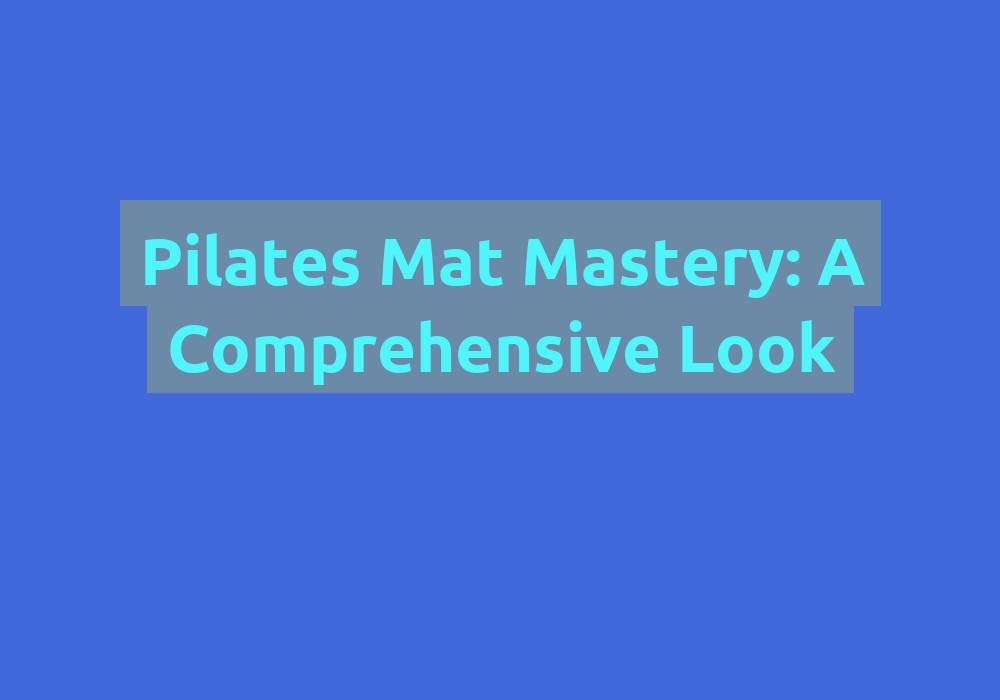Mat Pilates: Unraveling Core Concepts

Mat Pilates is a popular and effective form of exercise that focuses on core strength, flexibility, and overall body conditioning. Developed by Joseph Pilates in the early 20th century, this exercise regimen, originally known as Contrology, aims to improve physical strength, flexibility, coordination, and mental focus. In this article, we will delve into the core concepts of Mat Pilates, exploring its benefits, techniques, and key principles that make it a highly recommended exercise routine.
Understanding Mat Pilates
Mat Pilates primarily targets the body’s core muscles, which include the abdominals, back, pelvic floor, and glutes. By focusing on these key muscle groups, Mat Pilates helps improve posture, stability, and overall body alignment. This form of exercise can be done on a mat, making it accessible to individuals of all fitness levels.
Benefits of Mat Pilates
Improved Core Strength: Mat Pilates is renowned for its ability to strengthen the core muscles. By targeting and engaging these muscles, individuals can improve their posture, stability, and overall body alignment. This, in turn, helps reduce the risk of back pain and other muscular imbalances.
Enhanced Flexibility: Regular practice of Mat Pilates can significantly increase flexibility and joint mobility. The exercises involved in Mat Pilates lengthen and stretch the muscles, promoting a better range of motion and reducing the risk of injuries. Increased flexibility also aids in performing daily activities with ease.
Increased Body Awareness: Mat Pilates places a strong emphasis on the mind-body connection. Through conscious movement, participants are encouraged to focus on proper alignment and movement. This heightened body awareness translates into improved coordination, balance, and overall body control.
Effective Total Body Workout: While Mat Pilates primarily focuses on the core muscles, it engages multiple muscle groups throughout the body. This comprehensive workout helps tone and strengthen various muscle groups, including the arms, legs, and glutes. By targeting multiple muscle groups simultaneously, Mat Pilates provides a well-rounded exercise routine.
Low-Impact Exercise: Mat Pilates is a low-impact exercise that is gentle on the joints. This makes it suitable for individuals with joint pain or injuries. The controlled movements performed on a mat minimize impact and stress on the body while still providing an effective workout. It is the perfect option for individuals who want to stay active without putting excessive strain on their joints.
Stress Relief: Engaging in Mat Pilates requires focus and concentration, allowing individuals to disconnect from daily stresses. The controlled breathing techniques incorporated in Mat Pilates also promote relaxation and mental well-being. By practicing Mat Pilates, individuals can experience reduced stress levels and improved overall mental health.
Key Principles of Mat Pilates
To fully understand and reap the benefits of Mat Pilates, it is essential to grasp its core principles. These principles guide the practice and ensure proper form and technique. Here are the key principles:
1. Concentration
Concentration is a fundamental principle of Mat Pilates. By focusing your mind on each movement and being fully present in the exercise, you can effectively engage the targeted muscles and achieve maximum benefits from the exercise. Concentration also helps improve mental focus and mindfulness.
2. Control
Control is crucial in Mat Pilates to maintain proper form and prevent injury. Each movement should be executed with precision and intention, emphasizing quality over quantity. By practicing control, individuals can enhance muscle strength, flexibility, and overall body control.
3. Centering
Centering refers to the activation of the body’s core muscles, often referred to as the powerhouse. Initiating movements from the core provides stability, balance, and strength throughout the exercises. Centering allows individuals to develop a strong core foundation, which is essential for overall body strength and stability.
4. Breathing
Proper breathing is crucial in Mat Pilates. The breath should be deep and centered, with inhalation and exhalation coordinated with specific movements. This controlled breathing enhances focus, relaxation, and oxygenation of the muscles. It also helps individuals maintain a steady rhythm and flow throughout the exercises.
5. Precision
Precision in Mat Pilates involves executing each movement with accuracy and attention to detail. It emphasizes the alignment of the body and the engagement of the intended muscles, ensuring optimal results. By practicing precision, individuals can maximize the effectiveness of each exercise and avoid unnecessary strain or injury.
6. Flow
Flow refers to the seamless transition between movements in Mat Pilates. Each exercise should flow smoothly from one to the next, maintaining a constant rhythm and promoting grace and fluidity. Flow allows individuals to maintain a consistent pace and energy throughout the workout, enhancing the overall cardiovascular and muscular endurance.
Mat Pilates Techniques
Mat Pilates incorporates a variety of techniques that target different muscle groups and promote overall body conditioning. Here are a few commonly practiced techniques:
The Hundred: The Hundred is a classic Pilates move that engages the core muscles, particularly the abdominals. It involves lying on your back, lifting your head and shoulders off the mat, and pumping your arms while maintaining a strong core. This exercise helps strengthen the core, improves endurance, and increases blood circulation.
Roll-Up: The Roll-Up is an exercise that strengthens the abdominals and stretches the spine. Starting from a lying position, you gradually curl your body up, reaching for your toes, and then slowly roll back down. This exercise helps improve core strength, spinal flexibility, and overall body coordination.
Single Leg Circles: Single Leg Circles target the hip flexors, glutes, and core muscles. Lying on your back, you lift one leg off the mat and draw circles in the air, engaging the abdominal muscles for stability and control. This exercise helps improve hip mobility, core stability, and overall leg strength.
Plank: The Plank is an excellent exercise for strengthening the core, arms, and shoulders. It involves holding a push-up position with the body aligned from head to toe, engaging the abdominal and back muscles. This exercise helps improve core stability, upper body strength, and overall body posture.
Swimming: Swimming focuses on the back extensors and glutes while challenging core stability. Lying on your stomach, you lift your opposite arm and leg off the mat, alternating sides in a swimming motion. This exercise helps strengthen the back muscles, improve core stability, and enhance overall body coordination.
Conclusion
Mat Pilates offers numerous benefits for individuals of all fitness levels. By focusing on core strength, flexibility, and overall body conditioning, it provides a low-impact yet effective workout. Remember to incorporate the core principles of concentration, control, centering, breathing, precision, and flow into your practice to maximize the benefits of Mat Pilates. So grab a mat and start unraveling the core concepts of Mat Pilates for a stronger, more flexible, and balanced body.
FAQ
- What are the benefits of Mat Pilates?
- Mat Pilates improves core strength, enhances flexibility, increases body awareness, provides a total body workout, is low-impact, and offers stress relief.
- What are the key principles of Mat Pilates?
- The key principles of Mat Pilates are concentration, control, centering, breathing, precision, and flow.
- What techniques are commonly practiced in Mat Pilates?
- Commonly practiced techniques in Mat Pilates include The Hundred, Roll-Up, Single Leg Circles, Plank, and Swimming.
- Who can benefit from Mat Pilates?
- Mat Pilates is suitable for individuals of all fitness levels and is particularly beneficial for those looking to improve core strength, flexibility, and overall body conditioning while minimizing joint impact.

